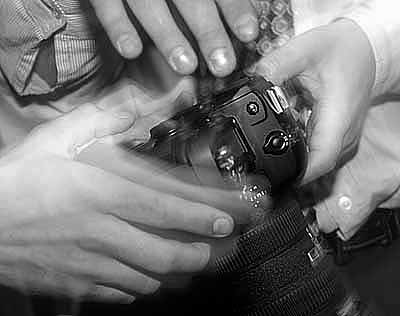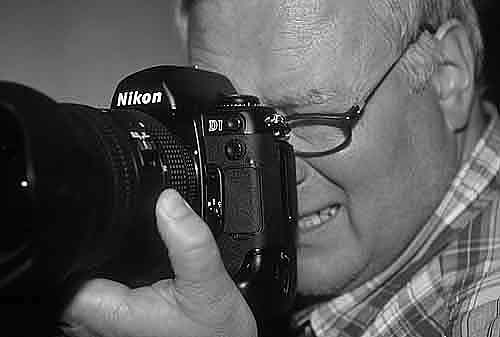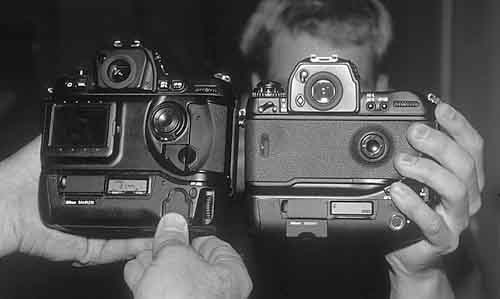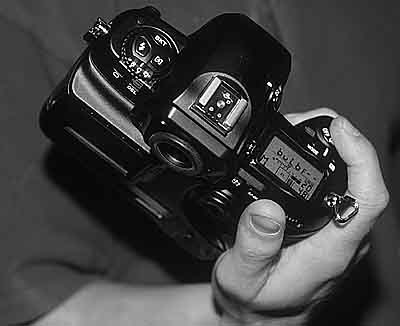 |
|
| Eager hands grasping for the Nikon D1 camera! |
The Beginning of An Era: First Impressions of the New Nikon D1
By Bjørn Rørslett
Review date 25 June, 1999
Just 10 days after Nikon officially announced their latest technology breakthrough, the Nikon D1 camera, I was standing in Oslo, Norway with it in my hands. This was the only working prototype in Europe, labelled Sample38, so the production models might well differ from the camera I tried. However, the external layout seemed perfectly finalised to me, so likely there only will be last-minute updates to the digital circuits and wizardry filling the innards of the D1.
I spoke to Nikon Europe representative Mr. Patrick Mollema of the Netherlands, and Mr. Egil Nilsson, CEO of Interfoto, the Norwegian Nikon distributor. This was the first press show for the D1, and a tribute to Interfoto's commitment towards a Digital Future for photography in Norway. Both were extremely proud of their new baby and understandingly not very keen on giving it away to my inquisitive eyes and fingers. Finally they did let go of it and so I had my first hands-on experience with the D1.
 |
|
| Eager hands grasping for the Nikon D1 camera! |
Immediately I was struck with the close resemblance of the D1 to F5/F100. The camera is substantially built and operates with an utmost ease. It can be used together with virtually all lenses ever manufactured for Nikon SLRs over the last decades (they have to be AI-compatible but otherwise all will fit). There is however an increase in the "effective" focal length with a factor of 1.5 times, this is caused by the smaller recording area of the D1 compared to an ordinary 35 mm camera. Nikon also launches a new AFS 17-35 mm f/2.8 ED-IF lens to go with the camera but the samples were still in Tokyo. I however have the press release including the lens diagram, and must say the design is the most "far-out" and hi-tech I've ever seen. Aspherical lenses we have encountered before, but not a front element that actually bulges inwards in the centre! There are plenty of inner aspherical and ED elements to ensure that this lens will deliver exceptional images. This lens is by the way specifically designed for the digital era to virtually eliminate chromatic aberrations, an optical error that adversely impact digital recording. The current 20-35 mm f/2.8 Nikkor isn't perfect in this respect and I reckon it will be discontinued in a short while when the new 17-35 hits the market (in fact, I already dumped mine to replace it with the superb AFS 28-70 mm f/2.8). On the D1, the 17-35 will equal a 25-50 mm for full-format 35 mm. Nikon representatives expressedly say the factory will not design optics specifically for the D1, but make them so as to be as cross-compatible as possible with the current line of film-based cameras. However, it's evident that better colour-correction of all new lens designs shall be given priority by Nikon. In photographic terms this means sharper images with enhanced colour saturation and contrast.
 |
|
| Looking to the Future: Nikon's D1 with the AFS 28-70 mm f/2.8 Nikkor |
Externally the Nikon D1 is very similar in size and weight to the F5. The controls and their layout also bear a close resemblance to those of the F5, but several improvements that emerged on the F100 have followed over to the D1. These include the rear AF-buttons that are enlarged and come with a rough surface to improve the finger grip and control, and a lockable focus-area selector equal that of F100.
 |
|
Rear
view of the Nikon D1 (left) and F5 (right) shows they are |
The viewfinder of D1 derives directly form F100 and is extremely bright and easy to read. This is helped enormously by the information being presented in subdued green-on-grey as with the F100, and there is a similar bright red outline of the currently selected focus field, too.
The camera responds instantaneously to a slight pressure on the release button, the delay before the shutter fires being only 58 millisecs. The top shutter speed is no less than 1/16.000 sec, something we surely have missed in the past (?), and the flash sync goes all the way up to 1/500 sec. The shutter speeds go down to 30 sec at the long end and there is a "B" setting too. The "normal" digital speed equals 200 ISO but can be increased to 1600.
There are a substantial number of custom functions (as on the F5) and the camera can be programmed to do all sorts of tricks. Remote control in particular is a breeze with it and dedicated Nikon software (Nikon Capture). Data are internally stored on flashcards. Nikon said the camera probably will be delivered with 128 MB cards, with even greater capacity cards to come. After each exposure has been made, a preview is available at the big LCD display at the rear of the camera. Technical information and histograms of pixel distribution vs. intensity can also be displayed. However, the sample camera outputted this in Japanese so I was at a loss to interpret the data, however it seemed to be very detailled.
 |
|
| Upper view of the D1 |
The D1 has a firing rate of up to 4.5 frames/sec. A total of 21 frames at max resoultion can be taken and stored in the camera's RAM before the data need to be written to the flashcard. Thus, there will be a short break while the D1 transfers the data and shooting can be resumed.
I was given an in-depth summary of all the various file formats and all the clever digital wizardry going on inside the D1. It has its own proprietary CPU called ASIC that does all the data analysis virtually in real time, so the data to be downloaded from the camera, either by Firewire or by the interchangeable flashcards, are already in correct format and fully colour-corrected. No additional processing by the host PC/Mac is needed to view the images. There is plenty of facilities for the photographer on-the-spot to do histogram and exposure analysis of the image data to decide whether or not a frame should be kept.
D1 carries the concept of multi-segmented matrix metering to a new level. There are no less than 1024 (yes, 1K) segments that read and store colour, brightness, contrast, and distance data. All these are exploited for the new 3-D Tonelevel Colour Matrix Metering. Yes, tonelevel - the camera cleverly do far more than just setting a proper shutter speed and aperture: Scene contrast and colour also are adjusted on the fly. Nikon has done some very ingenious tricks with the state-of-art CCD chip in their D1. There are 2.74 MPixels on the chip of which 2.62MPixels render the final image data and the remainder is for setting black points, automatic noise reduction and colour control.
The camera can output image data in a number of file formats. Besides standard types such as RGB TIFF and Jpeg, there are new YCbCr and "raw" formats giving the full 12 bit pixel depth. These formats can only be read by dedicated software, but do allow optimum use of the image data recorded by the CCD. Incidentally, the CCD is biased towards green with 50% of the pixels being allocated to green and only 25% each to the red and green primary colours. Nikon claims this gives much improved sharpness of the resulting digital image.
My News section gives a technical overview of the camera. The only thing now left for Nikon to research and improve is the ability of the LCD displays to withstand grease and finger marks ...
I go for my summer holidays now, but hopefully I'm getting a D1 production model early this autumn so I can give the camera a real work-out under Norwegian field conditions !
| To Top of Page | Back to the Photography Review Page | Back to Start Page |
Last update 26 June, 1999